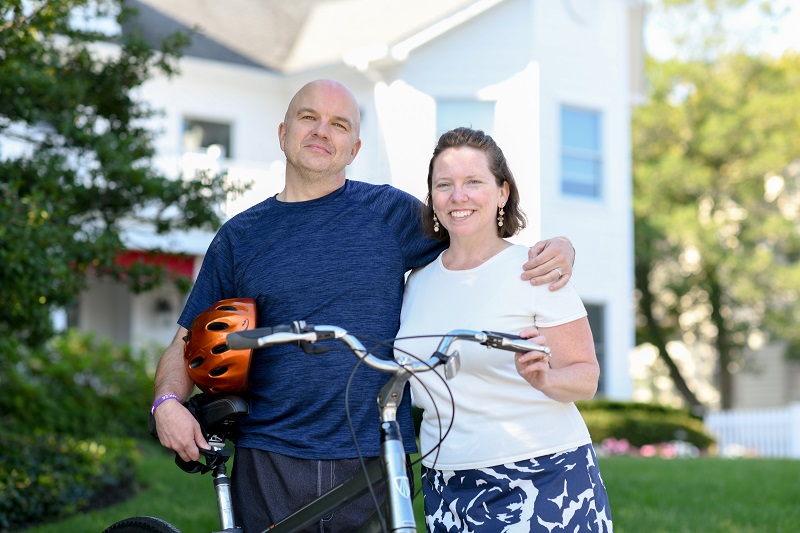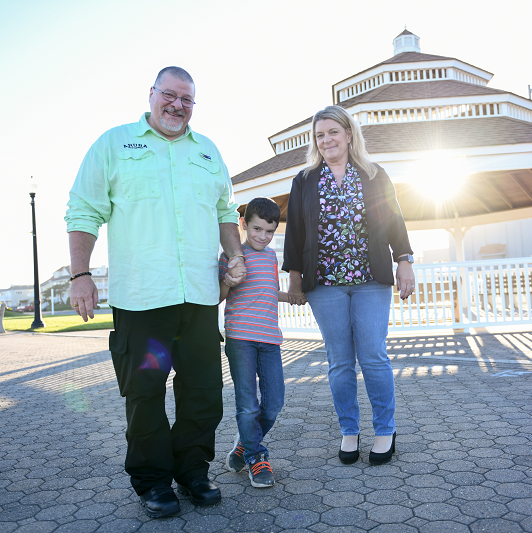Surgical Intervention Helps Man Breathe Easier After Accident

October 21, 2022
It all started on a sled, says David Shaw of Chapel Hill, North Carolina, who was playing in the snow in 2016 when he had a freak accident.
“I was sledding in my backyard and had a bad fall,” says David, 53, who is co-general manager of Yep Roc Records, an independent record label. “I flew off a retaining wall that’s about 12 to 18 inches off the ground and landed on my ice-covered cement driveway—right on my spine and tailbone.”
David broke two of his lower vertebrae and spent several years recovering in physical therapy. Then, in 2020, his wife drove him to the emergency room with excruciating abdominal pain, the source of which was his gallbladder. He had surgery to remove it but woke up days later with more debilitating pain in a different spot. This time, it was his right shoulder.
He eventually went to urgent care, where doctors prescribed muscle relaxants. What they presumed was a muscle cramp, however, ended up being much worse.
One day, he decided to take a walk to loosen up his tight muscles. “I was walking up a hill and, for the first time ever, understood the term ‘shortness of breath,’” David says. “As I was going up the hill, I was getting winded. I was really struggling to get a full breath. I would try to inhale, and my breath would just stop.”
So began a medical journey during which David learned he had a collapsed right lung as a result of a paralyzed phrenic nerve.
Finding a Diagnosis—and a Solution
“Your phrenic nerves control your diaphragm. Without them, you basically can’t breathe because your diaphragm won’t work,” says David. He eventually learned that his sledding accident years prior had likely damaged his right phrenic nerve, which was ultimately knocked offline by his gallbladder surgery. The shoulder pain he experienced afterward, he suspects, was the nerve dying.
David’s doctors in North Carolina told him he had only one option for treatment: diaphragm plication. His phrenic nerve—and therefore his diaphragm—would remain paralyzed, but his lungs would have slightly more capacity. “My pulmonologist told me my breathing might improve by 15–25 percent,” says David, who was not satisfied with those numbers. An active person who enjoys hiking, biking and walking his dog, he wanted more from his life and demanded more from his lungs.
Through internet research, David discovered another surgical option: Known as phrenic nerve reconstruction, outcome studies published by plastic surgeon Matthew Kaufman, M.D., and his team have shown it can offer a 25–35 percent improvement in breathing within the first year after surgery, and a 50–85 percent improvement within the second year.
“Patients with a paralyzed diaphragm traditionally have gone to their pulmonologist and been told either to live with it or to have a procedure done where the diaphragm is sutured and flattened—which pushes it down and allows the lung to open up, although it will not ever function again,” says Dr. Kaufman, who specializes in nerve reconstruction at the Center for Paralysis and Reconstructive Nerve Surgery at Jersey Shore University Medical Center. “With phrenic nerve reconstruction, we try to get the diaphragm to move again by restoring function of the phrenic nerve.”
Dr. Kaufman began performing the surgery in 2007 and has a success rate approaching 90 percent. During the procedure, he removes scar tissue from around the phrenic nerve and, in some cases, transplants a small piece of nerve from the patient’s leg to the injury site. There, he “hotwires” the leg nerve to the phrenic nerve, creating a bypass around the injury so the nerve signal can travel from the brain to the diaphragm.
Breathing Again After Surgery
After he found him on the internet, David consulted Dr. Kaufman and discovered he was a good surgical candidate. He traveled to New Jersey for the procedure in April 2021 and, with the help of physical therapy, has made significant strides since.
“David is doing extraordinarily well,” Dr. Kaufman says. “He’s making tremendous improvements and has been able to resume a lot of the activities that he was able to do before.”
One of those activities is playing the drums. David began taking lessons during the COVID-19 pandemic. Before his surgery, he used his phone to record himself playing and was shocked at what he heard: He played for only a minute and a half before huffing and puffing his way across the room, audibly gasping for breath as he reached for the phone to stop recording. When he recorded himself playing again recently, he played for more than 5 minutes without a single huff or puff.
“Before my surgery, I would get winded just walking up a flight of stairs,” David says. “I would get lightheaded walking with my dog. I had trouble sleeping because I couldn’t breathe at night. I would wake up in the morning with headaches because I wasn’t getting enough oxygen. None of that is happening anymore. I can actually breathe again.”
Next Steps & Resources:
- Meet our source: Matthew Kaufman, M.D.
- To make an appointment with Dr. Kaufman or a surgeon near you, call 800-822-8905 or visit our website.
The material provided through HealthU is intended to be used as general information only and should not replace the advice of your physician. Always consult your physician for individual care.







